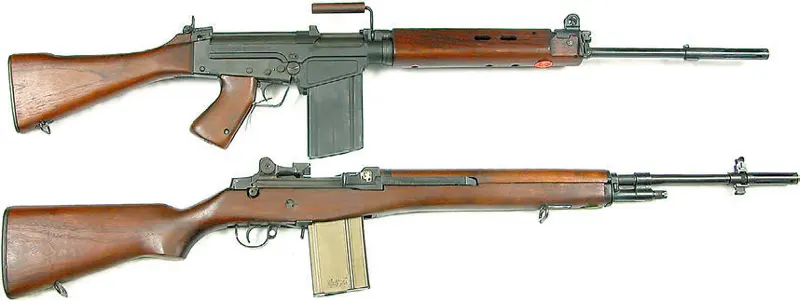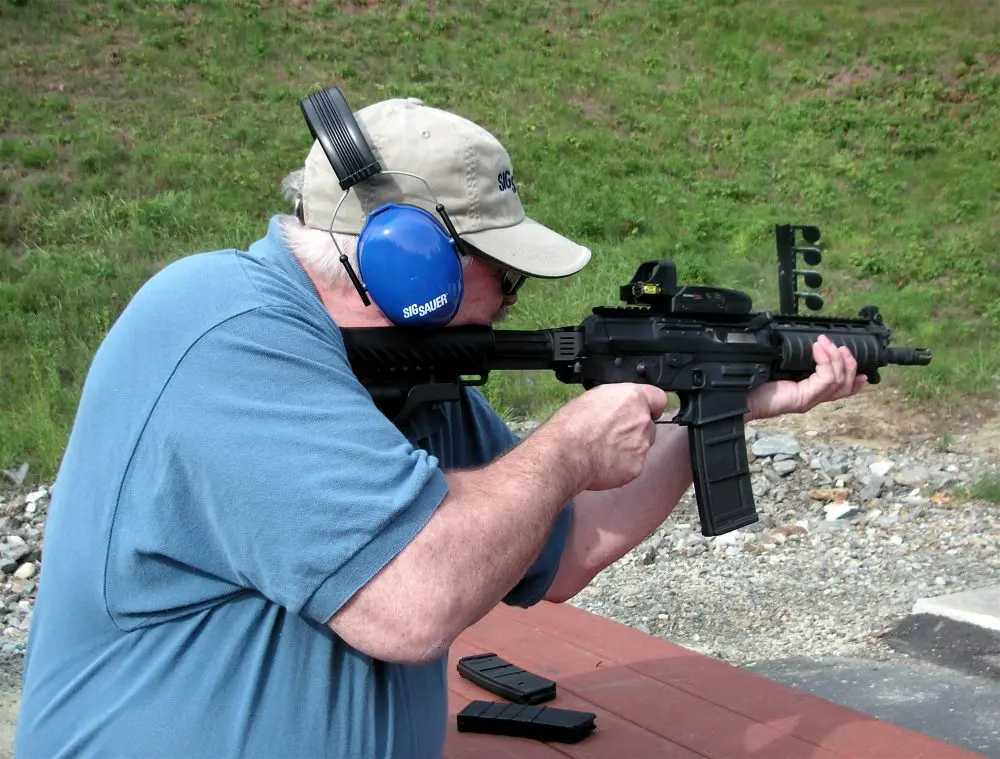During World War II, the self-loading M1 Garand rifle gave U.S. Army and Marine infantrymen a distinct advantage over Japanese and German infantrymen armed with boltaction rifles.
However, as much as GIs appreciated the Garand, they often expressed the wish that it had a larger magazine capacity than eight rounds and offered full-auto capability.
During the war, the Germans had developed rifles that far outpaced the bolt-action Mauser 98K and in many ways the Garand. These included the FG 42 and StG 44 rifles. U.S. Ordnance Intelligence personnel had examined the FG 42, influencing Springfield Armory engineers to begin working on development of a version of the Garand with a detachable 20-round magazine and select-fire capability.
Attempts to improve the Garand continued after the end of World War II, while the standard M1 remained the U.S.- issue weapon through the Korean War and after. Two problems with producing a select-fire Garand were the recoil and muzzle rise with the .30-06 round.
The Germans had realized this with the StG 44, which is generally considered the first assault rifle, and had chambered it for the 7.62 Kurz (short) cartridge.

Although longer and more powerful than the 7.62 Kurz round, the T65 cartridge was developed by the U.S. This would become the 7.62x51mm NATO round. The rifle intended for the T65 cartridge was the T25, but that project was terminated in 1951.
Alongside the T25, various other “T” designs were developed in the late 1940s and early 1950s. One, the T31, was a bullpup design intended to replace the rifle, carbine, SMG, and squad automatic weapons then in use. Although the design did not proceed past prototypes, its magazine would later prove the basis for the M14 magazine.

It was the T44 that seemed to show the most promise and was the forerunner of the M14 design. Between August and December 1952, a series of trials were held of various rifles including the T44 and the FN FAL (designated the T48). The T48 was rated the winner by the trials board, with the T44 second.
Alterations were made to the T44 based on problems during the earlier trials, and in June 1953, additional trials were carried out at Ft. Benning, Georgia against the T48. The T44 still had more malfunctions than the T48, resulting in a recommendation by the Trials Board that the T48 be adopted, and authorizing the Ordnance Corps to order 3,000 FALs for further testing.
But the Ordnance Corps wanted to see how the rifles performed in Arctic trials, so Springfield Armory was authorized to prepare a group of T44 rifles for cold weather trials in late 1953/early 1954 in Alaska. The T44 outperformed the T48 in the Arctic, resulting in another group of Arctic trials scheduled during the winter of 1954/55.
As the FAL would have to be produced in the U.S. if adopted, High Standard—working with Springfield Armory— was working on converting the metric FAL drawings to inches to begin production. However, Harrington & Richardson was actually given the contract to produce 500 T48 rifles.
Springfield Armory had begun production of 500 T44E4 rifles, but H&R had difficulties getting T48 production underway. Testing of the two rifles did not begin until October 1955. In a test over a combat course at Ft. Benning, the T44E4 rifles malfunctioned 1.4% of the time and the T48 rifles 2.4% of the time.

Springfield Armory and H&R worked on improving the test guns for a new round of tests, and both had their rifles ready two months later. Tests began again at Aberdeen Proving Ground, but the T48 failed the accuracy tests due to H&R using incorrect barrel tolerances, which resulted in oversize bores.
More tests using the T44E4, H&R T48, and FN FAL were scheduled to begin in April 1956. During that year, various trials were run over the Ft. Benning Combat Course, resulting in the conclusion that both the T44E4 and T48 were suitable for use by the U.S. Army.
By this time, though, the T48/FAL didn’t really stand a chance, as the Pentagon wanted to adopt a U.S. design and argued that the T44E4 had fewer parts, used a gas flow system that did not require manual adjustments, and was lighter than the T48 by a pound. On 1 May 1957, the T44E4 was adopted as the M14.
Pentagon politics played a large part in the adoption of the M14, though politics would also have played a part in the adoption of the T48.
The U.S.’s NATO allies were applying pressure to adopt the FAL, which had been or would be adopted by NATO members Belgium, Canada, Greece, Luxembourg, Netherlands, Portugal, United Kingdom and West Germany. In part, there seems to have been a tacit agreement that if NATO would adopt the 7.62x51mm round as its standard cartridge, the U.S. would adopt the FAL.
It didn’t happen, and NATO members were even less happy when the U.S. replaced the 7.62x51mm cartridge, which they felt had been forced upon them, with the 5.56x45mm round a decade later.
The question remains: was the U.S. better off adopting the M14 instead of the FAL? In either case, entry into the Vietnam War would almost assuredly still have resulted in the adoption of the M16. I have to admit that I am a big fan of the FAL, but I have also come to appreciate the M1A and the M14 over the years.
I believe that the M14 did prove more accurate in testing, to some extent due to its better sights. They were adjustable for windage and elevation, while the standard FAL sights were a rear aperture and front post, which were quite basic. The M14 safety—the same as the M1 Garand—is easily pushed off with the trigger finger as it enters the trigger guard, while the FAL uses a selector on the left side of the receiver that requires shifting the shooting hand to operate it with the thumb.
On the other hand, the FAL incorporates the safety into the selector, while the M14’s selector is separate and located on the top right of the receiver. Since most M14s were issued with the selector removed, it was not used by most troops anyway.
I prefer the FAL’s cocking handle on the left side of the rifle, allowing it to be operated with the support hand, to the M14’s cocking handle, which is quite similar to that of the Garand.
My biggest problem with the M14/M1A is that it has always seemed dead in my hands. The FAL, by contrast, is much better balanced and lively. I think the pistol grip increases its handiness and definitely makes it easier to control in full-auto fire. Some of the chassis they are using for the DMR versions of the M14 deal with the issues of balance and comfort and shoot very well.
The decision to adopt the M14 instead of the T48/FAL was made over half a century ago, so today it’s a moot point. And we did eventually adopt a non-U.S. design for our service pistol in the M9. Today, deciding whether one prefers the M14 or the FAL is like the old blondes versus redheads discussion.
But I will say that I have a DSA FAL Para with Picatinny rail that will shoot MOA or almost, and is very reliable. I shoot a lot of battle rifles, and I’d put that DSA Para up with the best of them. But the GIs fighting the Cold War wouldn’t have had my custom-built DSA. They’d have had a mass-produced FAL.
Mostly, it’s interesting to think that we might have had a U.S. GI FAL. FAL magazines are already inexpensive, and that would have made them even cheaper.

